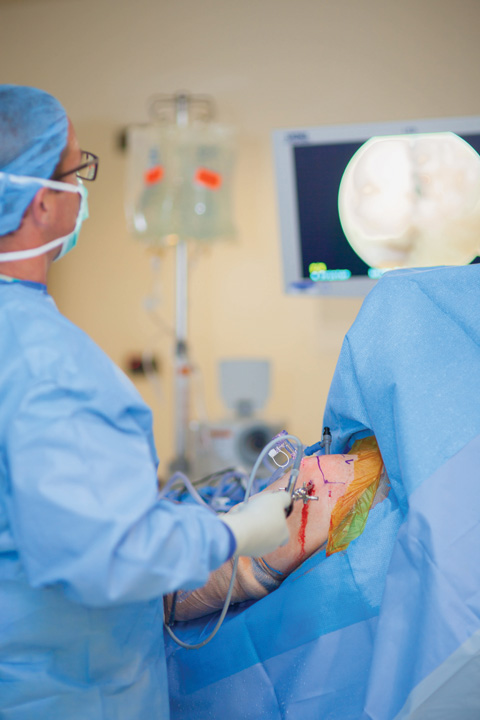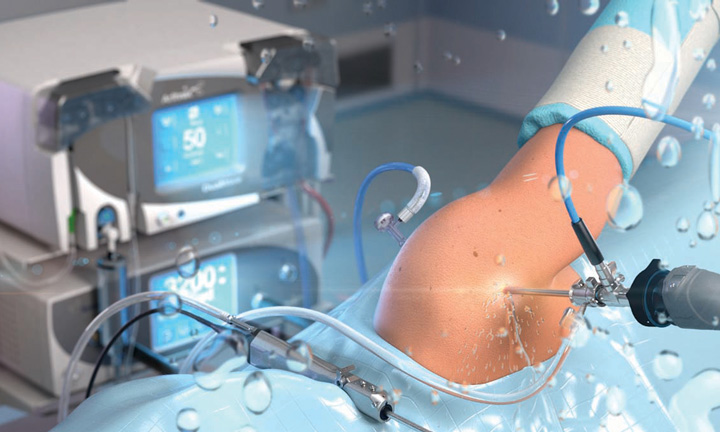- Home
- Article
Arthroscopic Visualization’s Constant Evolution
By: Adam Taylor | Managing Editor
Published: 6/27/2024
The clearest images produce the greatest outcomes, so having the best equipment is a must.
For arthroscopic surgeons, seeing is succeeding. They need their technology to deliver clear, detailed and brilliant images from surgical fields that are dark and full of fluid. That’s why all components of the imaging chain — from the camera head to the monitor — are critical to successful joint procedures. Arthroscopic visualization platforms also need elements that allow all components to work in unison. Some parts of the package must be tough as nails, as high-volume surgical operations run them through the rigors of sterile processing multiple times a day. Put together, the systems and the surgeons achieve seemingly impossible outcomes.
Revolutionary advances
“Everything is constantly evolving, and our industry partners have really revolutionized how we do things, particularly arthroscopic repairs. Whether it be meniscal repairs or rotator cuff repairs, the instrumentation that’s been developed and is always improving makes the outcomes more reproducible,” says Andrew C. Stoeckl, MD, a board-certified, Harvard-trained surgeon who performs total joint replacements and arthroscopic knee and shoulder surgeries at Excelsior Orthopaedics in Buffalo, N.Y. “It allows surgeons of varying levels of experience to be facile performing these repairs because of the technology and better instrumentation.”
Here’s a look at various elements of arthroscopy systems that can make the visualization picture crystal clear.
Each evolution of this instrumentation helps lead to more consistent outcomes.
Andrew C. Stoeckl, MD
Nanotechnology
This is a hot topic among orthopedists, says Dr. Stoeckl. The scope is more narrow than traditional arthroscopes. It has a camera on the tip and is inserted through a needle cannula. Unlike traditional arthroscopy, incisions aren’t needed, patients don’t need general anesthesia and procedures don’t need to be performed in operating rooms. Proponents say high patient satisfaction rates from less nerve damage, faster recoveries and improved outcomes will make nanoscope procedures quite popular one day soon.
“It’s an interesting technology where you essentially use a large-bore needle to look into a joint, exposing the joint to more minimally invasive surgery that is less likely to damage healthy cartilage, but still provides excellent visualization of the joint,” says Dr. Stoeckl. “Some companies are really trying to get it into outpatient surgery centers.”
Ultra-high-def imaging
The future of surgical video lies in 5K and even 8K video — the latter of which will provide eight times the resolution and eight times the color of standard high-definition platforms. For now, however, an upgrade to any number of 4K ultra-high-definition video platforms will do. Systems have gone from good standard-definition ones to great high-definition ones — and now beyond.
“The ultra-high-definition cameras that are coming up through the pipeline definitely improve visualization, which can lead to better patient safety and better outcomes,” notes Dr. Stoeckl.
All links in the optical chain work together to transmit clear and brilliant imagery to the surgeons. 4K systems give detailed images with color contrast that provide the most accurate picture. It’s always important to think of the “true 4K” concept, as a 4K camera attached to a non-4K monitor won’t provide the real-life images of tissue and anatomy that are sought. Large wall-mounted monitors allow the entire perioperative team to see that the surgeon is seeing in real-time.
Beyond picture quality, interconnectivity is a prime consideration as well. Platforms allow arthroscopy images to integrate with patients’ electronic medical records and cano electronically transmit images to a surgeon’s office or show a patient’s family images from the procedure on a tablet. Integrating with recordkeeping departments saves time and money, and essentially eliminates the need for staff to compile time-consuming paper charts for surgeons.
Modern platforms offer voice command and tablet control features that allow control of the arthroscopy tower from a nursing station away from the sterile field. Surgeons who teach can don headsets to start and end instructional videos by simply talking to the tower from the field.
Video and images can be loaded to a CD or directly to the platform’s server. The models with cloud-based data storage are helpful in that they allow everyone on the patient’s care team to upload and access it.
Many new systems are fully autoclavable, including the camera heads. Wireless platforms help arthroscopy teams with durability, longevity, sterility and efficiency, notes Dr. Stoeckl.
“There’s less concern about breaks in the sterile technique because you don’t have cords going from the sterile to the nonsterile field,” he says. “Wireless systems are quicker to set up. And cords aren’t tremendously durable because they go through the processing along with the cameras to be sterilized. Issues with cords are a frequent weak point when high-volume centers use equipment like this that needs to be serviced frequently.”
Automated irrigation pumps

Just more than a decade ago, many irrigation pumps had rudimentary low, medium and high levels of control. Going back a little further than that, members of the OR team acted as human flow switches, which Dr. Stoeckl remembers all too well.
“Ten years ago, you’d just raise them higher to the ceiling to get more gravity effect,” he says. “Twenty years ago, nurses would sometimes have to squeeze the IV bag to increase the pressure in the joint to control bleeding.”
Continued advances in irrigation pumps have raised the standard of modern arthroscopy and decreased the need for the use of tourniquets. The newer pumps make fluid management very consistent, which it needs to be, as excellent arthroscopic visualization requires a variable, adequate flow rate and maintenance of distention pressure in the joint. Fluid is injected into the joint during procedures, but some escapes as the shavers and burrs are used. Modern pumps keep the joint from drying and the surgical field stable while optimizing the visualization within the operative space.
“Now we’re able to set the millimeters of mercury at, say, 40 millimeters and the pump maintains that pressure throughout the case,” explains Dr. Stoeckl. “If there’s a leak, or an instrument allows some egress of water, the pump will either ramp up or ramp down to maintain a predetermined pressure.”
Maintaining distention pressure is important to minimize bleeding to keep the field clear so surgeons can work fast and aggressively to prevent the case from taking longer than necessary.
Some surgeons prefer the use of models that have foot pedals to operate the pumps, while others like the ones that feature remote hand controls to regulate the pressure levels.
“With the hand controls, the surgeon can turn up the pump pressure with extreme precision if the patient’s blood pressure is high or if there are problems with visualization due to bleeding,” says Dr. Stoeckl. “The pump will maintain that pressure even if there’s some egress of fluid.”
Sales and service

It’s not easy to differentiate between the systems that are available, because they’re all very good. “All vendors are providing exceptional visualization and interconnectivity,” notes Brian Bizub, CEO of Raleigh (N.C.) Orthopaedic Clinic. “If not, they would not be a contender for equipment selection.”
The best bet when making a purchasing decision is to rely on a company’s reputation for quality and record of responsiveness. When trialing a system, be sure to get exposure to and use as many of its components as possible, including radiofrequency and thermal ablation wands, as well as all the burrs, shavers and irrigation pumps. Compare the brilliance of images offered by the camera head and monitors of different companies.
Make sure to compare costs of all options. For example, learn the cost differences between single- and multi-use tubing. Involve as many surgeons as possible in the trials and get a consensus — or at least a majority opinion — on which handles feel best in their hands and seem to the most ergonomically sound systems overall. The higher the volume at a facility is, the more autoclavability should factor into purchasing decisions. Exploring cost-saving opportunities through bundled packages always makes sense. Purchasing decisions can often come down to which company can bundle the most components into a single cost-effective package.
“Most facilities would demo the towers by different vendors in the ASC prior to purchasing and only with the surgeons’ approval,” says Mr. Bizub. “Other things to consider are disposable contracts and rebates that would help a facility pick the right vendor if the physicians felt that each tower they trialed was exceptional. Financing and tiered pricing are also important in the purchasing decision.”
While today’s new and improved arthroscopy equipment is amazing, — especially when compared to what OR teams had to work with just a decade ago when visualizing — accessing and repairing damaged joints, the innovations that will arrive in the near future will undoubtedly be even more exciting.
“Each evolution of this instrumentation helps lead to more consistent outcomes,” says Dr. Stoeckl. OSM
.svg?sfvrsn=be606e78_3)
.svg?sfvrsn=56b2f850_5)